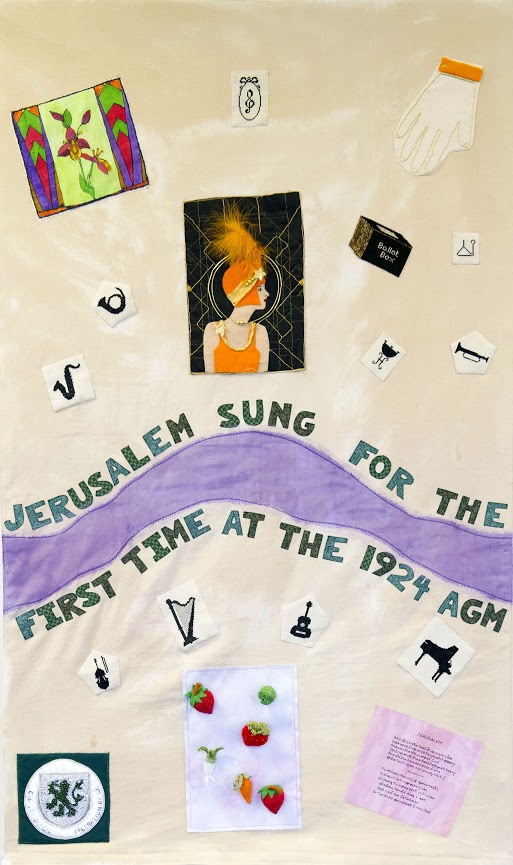Content can be downloaded for non-commercial purposes, such as for personal use or in educational resources.
For commercial purposes please contact the copyright holder directly.
Read more about the The Creative Archive Licence.
Description
Once the war was over the newly formed WIs began to concentrate on planning programmes of activities to suit their members. The new organisation attracted members from the Lady of the Manor, to her housemaid and cook; from the local shop keeper to the wife of the farm labourer: working together in the WI helped to break down the social barriers between countrywomen who had rarely met in the past.
The activities the members were involved in were many as represented on the panel. The musical instruments embroidered into Aida fabric, represents the WI’s involvement with music. In
1922 an informal music school was held in mid Wales and included ‘sight reading, conducting and melody making’. In 1923 the first WI choral competition for WI choirs was held in East Sussex and in 1924 Jerusalem was sung for the first time at the AGM, with an arrangement for string orchestra and women’s voices specially composed for the WI by Sir Walford Davies.
This started a tradition that continues to this day and marks the WI’s links with the wider women’s movement, and its commitment to improving the conditions of rural life. Jerusalem had been used by the National Union of Women’s Suffrage Societies (NUWSS) in the 1918 celebrations of women enfranchisement, and many leaders of the WI including Grace Hadow, had been a part of that struggle to win the vote for women. Millicent Fawcett, one of the leaders of the suffragists, wrote to Hubert Parry, ‘Your Jerusalem ought to be made the women voters’ hymn’, which of course in a way it was, being adopted by the WI. Parry’s Executors gave the copyright to the WI in 1928 when the NUWSS was disbanded, having achieved its aims. This is celebrated on the panel with appliquéd lettering and numbers using various green fabrics on Aida fabric and frames the timeline in lilac voile and white netting coloured with a purple ink pad.
The music is also acknowledgment of the Llangollen International Musical Eisteddfod which is held in Llangollen every year, within Clwyd Denbigh Federation.The collage of fruit and
vegetables with a printed textured fabric background and knitted and felt strawberries and vegetables highlights the importance of teaching women skills which was one of the reasons why the WI was formed in 1915. In 1920 the Guild of Learners was formed to ‘improve conditions of rural life by encouraging home and local industries’ and to ‘regain the practice of home handicrafts with a view to restoring best traditions of workmanship’.
The ballot box in beadwork with the hand in gold thread and orange felt on calico symbolises the 1928 Equal Franchise Bill which meant that all women over 21 could vote. In the same decade Mrs Margaret Winteringham, WI member and Honorary Secretary to Lindsey (Lincolnshire) Federation, was elected as Member of Parliament for Louth. She was the first English born female MP and only the second woman to be elected to Parliament. She described her membership of the WI as the best training she could have had for her work as an MP.
Also during this decade the uniqueness and importance of the Welsh federations was recognised and a Welsh speaking member was co-opted on to the NFWI Executive and the first Welsh Counties conference was held.The flapper lady made with black satin, felt, gold work, gold thread and feathers is synonymous with the 1920s. The flapper was as giddy and risk taking, she smoked, drank, wore makeup and went to parties. Her clothing was trimmed down and lightened to make movement easier. The silk painting of an orchid is one found on Llandegla Moor which lies between Wrexham and Ruthin.
The federation badge has a green fabric background with a white satin surround and silver
cord, and shows the lion of Denbigh in green fabric and beads. The lion was the heraldic badge of
the Salusbury family who owned large tracts of land in Denbighshire.






Do you have information to add to this item? Please leave a comment
Comments (0)
You must be logged in to leave a comment